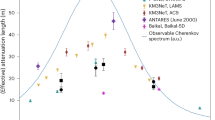Abstract
In our nuclear era, suspicions exist about the fate of the Earth’s ozone layer: both large- and local-scale conflicts, using nuclear weapons, are thought to be able to destroy the ozone layer for years to come. On September 22, 1979, an officially unidentified state covertly performed the nighttime nuclear weapon test in a desolate region of the World Ocean. This event is conventionally called the Vela Incident. In this work, we used ozone data obtained by the NASA satellite Nimbus-7 16 min and 44 s after the explosion. It is shown that the shock wave left a “trace” in the ozone layer. No decrease in the ozone amount is noticed. The coordinates of the explosion site are determined from the trace.



Similar content being viewed by others
REFERENCES
Yu. A. Izrael’, “Large-scale geophysical and environmental consequences of a possible nuclear war,” in Large-scale Climatic and Biological Consequences of a Nuclear War (Nauka, Moscow, 1986), p. 46–65 [in Russian].
V. B. Kashkin, T. V. Rubleva, and R. G. Khlebopros, Stratospheric Ozone: View from Space (Siberian Federal University, Krasnoyarsk, 2015) [in Russian].
K. Ya. Kondrat’ev, “Global ozone dynamics,” in Scientific and Engineering Results. Geomagnetism and Upper Atmosphere (VINITI, Moscow, 1989), vol. 11 [in Russian].
E. L. Aleksandrov, Yu. A. Izrael’, I. D. Karol’, and A. Kh. Khrgian, Earth’s Ozone Shield and Its Changes (Gidrometeoizdat, St. Petersburg, 1992) [in Russian].
H. Johnston, G. Whitten, and J. Birks, “The effect of nuclear explosions on stratospheric nitric oxide and ozone,” J. Geophys. Res. 78 (27), 6107–6135 (1973).
V. V. Zuev, N. E. Zueva, and E. S. Savel’eva, “Specificity of formation of the Antarctic and Arctic ozone anomalies,” Opt. Atmos. Okeana 27 (5), 407–412 (2014).
E. Bauer and F. R. Gilmore, “Effect of atmospheric nuclear explosions on total ozone,” Rev. Geophys. 13 (4), 451–458 (1975).
O. B. Toon, A. Robock, R. P. Turco, C. Bardeen, L. Oman, and G. L. Stenchikovet, “Consequences of regional-scale nuclear conflicts,” Science 315 (5816), 1224–1225 (2007).
C. Sublette, “Report on the 1979 Vela Incident,” Nuclear Weapon Archive, 6–7 (2001). https://nuclearweaponarchive.org/Safrica/Vela.html. Cited December 15, 2020.
NASA's HEASARC. https://heasarc.gsfc.nasa.gov. Cited December 15, 2020.
L. E. De Geer and C. M. Wright, “The 22 September 1979 Vela incident: Radionuclide and hydroacoustic evidence,” Sci. Glob. Secur. 26 (1), 20–54 (2018).
Nuclear Weapon Effect (Voennoe izdatel’stvo ministerstva oborony SSSR, Moscow, 1965) [in Russian].
E. Guy and G. E. Barasch, Light Flash Produced by an Atmospheric Nuclear Explosion (University of California, Los Alamos, 1979).
R. D. McPeters, P. K. Bhartia, A. J. Krueger, and J. R. Herman, Nimbus-7 TOMS. User`s Guide (NASA, 1996).
D. E. Andersen, Computing NORAD Mean Orbital Elements from a State Vector. Thesis Air Force Institute of Technology (NASA Astrophysics Data System, Harvard, 1994), p. 1–9.
https://ozonewatch.gsfc.nasa.gov. Cited January 11, 2021.
V. B. Kashkin and A. I. Suhinin, Remote Sensing of Earth from Space. Imagery Digital Processing (Logos, Moscow, 2001) [in Russian].
J. W. Reed, “Air blast in subsurface bursts,” in Subsurface Bursts, Ed. By V.N. Nikolaevskii (Mir, Moscow, 1974), p. 293–413 [in Russian].
ACKNOWLEDGMENTS
The authors thank T. S. Kelso for providing the orbital data from Nimbus-7 satellite and V. Yu. Romasko for calculating the orbit.
Author information
Authors and Affiliations
Corresponding authors
Ethics declarations
The authors declare that they have no conflicts of interest.
Additional information
Translated by O. Bazhenov
Rights and permissions
About this article
Cite this article
Kashkin, V.B., Odintsov, R.V. & Rubleva, T.V. On the Effects of a Nuclear Explosion on Stratospheric Ozone. Atmos Ocean Opt 35, 402–406 (2022). https://doi.org/10.1134/S1024856022040066
Received:
Revised:
Accepted:
Published:
Issue Date:
DOI: https://doi.org/10.1134/S1024856022040066




